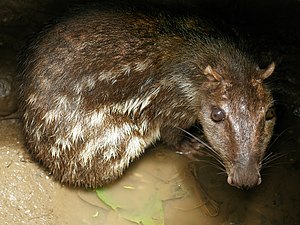Pakas
| Pakas | ||||||||||||
|---|---|---|---|---|---|---|---|---|---|---|---|---|

Paka ( Cuniculus paca ) |
||||||||||||
| Systematics | ||||||||||||
|
||||||||||||
| Scientific name of the family | ||||||||||||
| Cuniculidae | ||||||||||||
| Miller & Gidley , 1918 | ||||||||||||
| Scientific name of the genus | ||||||||||||
| Cuniculus | ||||||||||||
| Brisson , 1762 | ||||||||||||
| species | ||||||||||||
|
The Pakas (generic name Cuniculus , Latin for " rabbit ") are an American genus of mammals belonging to the rodent order . They are run in their own family, Cuniculidae. Sometimes they are also counted among the agoutis and acouchis (Dasyproctidae), but they should not be very closely related to these. There are two types, the Paka ( Cuniculus paca ) and the Bergpaka ( Cuniculus taczanowskii ).
Appearance
The paka's fur is brown in color and has four rows of white spots on each side of the body, the underside is lighter, almost whitish. Your head is thick and angular and looks swollen. They have a short neck and a stocky body with strong legs. The front feet end in four toes, the rear feet in three (the remaining toes are present, but receded). Each toe ends in a hoof-like claw. Pakas reach a head body length of 60 to 80 centimeters, the tail is stunted and only two to three centimeters long. The weight of these animals is six to twelve kilos, with the males becoming a little heavier.
distribution
Pakas live in tropical forests in Central and South America . Their distribution area extends from Mexico to Brazil and Paraguay .
behavior
Pakas are found in a number of habitats, but prefer forests near water. They are nocturnal and spend the day in an underground burrow that they have dug themselves or taken over from other animals. These burrows are simple tubes that extend up to two meters below the ground and are often located under tree roots or rocks. To ensure better escape routes, they often have several exits. After dusk, they go in search of food. Pakas are ground dwellers who do not climb trees, but they can swim and dive well and often flee into the water from predators. In general, they are very shy and cautious. Outside of the mating season, they live solitary.
food
Pakas are herbivores, their diet consists of leaves, stems, roots and fallen fruit.
Reproduction
There is different information about the reproduction of the Pakas. While they have a fixed mating season in Mexico (young animals are born in the dry season in winter or spring), in other regions they can give birth all year round, sometimes two litters per year. The gestation period is around 120 days, the litter size one to two. Young animals are weaned after around three months and reach sexual maturity at around one year. Life expectancy in the wild is a maximum of 12 to 13 years, in human care up to 16 years.
Pakas and people
Pakas are considered pests in some places because they invade plantations and devastate them. Their meat is considered a delicacy and achieves high prices. For these reasons, they are hunted and have become rare in some regions. Overall, however, they are not endangered, only the mountain paka, which lives in the Andean region in northern South America, is considered to be at low risk.
Name and system
The scientific name Agouti , Lacépède, 1799 is also found for the pakas , which often led to confusion as it was not applied to the agoutis . Both names, agouti and cuniculus , were used in parallel for a long time before the ICZN declared agouti invalid and cuniculus the only valid name in 1994 .
The Bergpaka ( C. taczanowskii ) is sometimes in the genus Stictomys performed, but only a synonym for Cuniculus is.
Pakas are a separate family (Cuniculidae) in the system that applies here, which is based on Wilson and Reeder (2005). Occasionally, the names Agoutidae or Agoutinae are also found for this taxon . Sometimes they are also grouped together with the agoutis and acouchis .
literature
- Malcolm C. McKenna, Susan K. Bell: Classification of Mammals. Above the species level. Revised edition. Columbia University Press, New York NY 2000, ISBN 0-231-11013-8 .
- Ronald M. Nowak: Walker's Mammals of the World. 2 volumes. 6th edition. Johns Hopkins University Press, Baltimore MD et al. 1999, ISBN 0-8018-5789-9 .
- Don E. Wilson , DeeAnn M. Reeder (Eds.): Mammal Species of the World. A taxonomic and geographic Reference. 2 volumes. 3. Edition. Johns Hopkins University Press, Baltimore MD 2005, ISBN 0-8018-8221-4 .